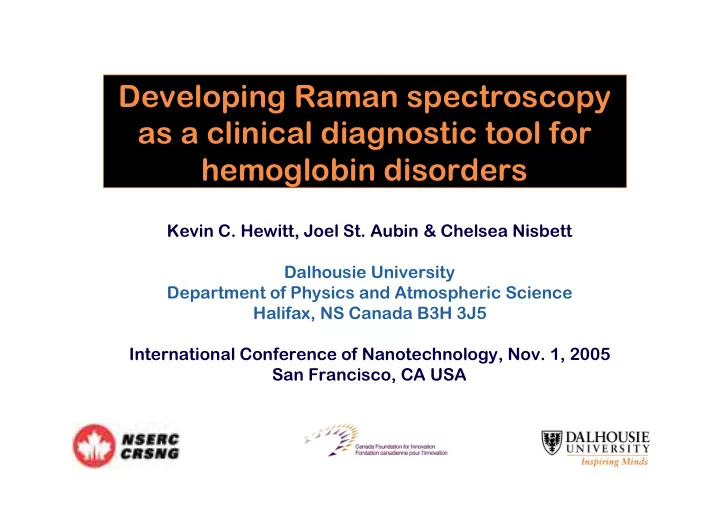

Developing Raman spectroscopy as a clinical diagnostic tool for hemoglobin disorders Kevin C. Hewitt, Joel St. Aubin & Chelsea Nisbett Dalhousie University Department of Physics and Atmospheric Science Halifax, NS Canada B3H 3J5 International Conference of Nanotechnology, Nov. 1, 2005 San Francisco, CA USA
Outline Motivation Hemoglobinopathies, e.g. Sickle cell disease (HbS) Raman spectra of amino acids L-Glutamic Acid L-Valine Raman Spectra of HbA and HbS Conclusions
Hemoglobin disorders Qualitative (e.g. amino acid substitutions) or quantitative (loss of portions of hemoglobin protein) changes in the oxygen-carrying protein hemoglobin (Hb) 75% of immigrant groups to Canada belong to at risk groups 270 million carriers worldwide Canadian Quality Management Program laboratory services survey (1990-2000) found “recurrent errors in diagnosis of carrier genotypes for serious hemoglobinopathies” A complementary technique is needed. Selectivity, sensitivity, cost, ease of use, turn- around time
Hemoglobinopathy, e.g. Sickle Cell disease Oxygenated RBC with HbS looks normal but once deoxygenated it HbA shows the characteristic sickle shape. HbS �Single Amino acid substitution on both beta chains. �Valine is hydrophobic while Glutamic Acid is hydrophilic.
Raman Spectroscopy Why Raman scattering? Inelastic light scattering. Energy of the scattered photon changes due to its interaction with vibrational quanta (phonons) in the sample. Vibrational modes determined by mass, bond type, and symmetry of the atoms in the solid. Raman spectra gives molecular information - SPECTRAL FINGERPRINT of compound No special sample preparation necessary.
Raman Spectroscopy
Experimental arrangement Laser Grating Beam splitter CCD Detector Objective lens Sample Concave focusing mirror
COO - def Raman spectra – valine & glutamic acid C-C str. C-C str. C-C str. C-COO - str C-C str. C-C str. C-C str. NH 3 + Def. NH 3 + def CH 2 wag. CH 2 wag CH 3 symm. def CH 2 wag. CO - symm. str. CH 2 sci. CH 3 asymm. def CH 2 sci.
Conventional Raman spectra - HbA & HbS 1000 HbA Change of 2 in 574 Intensity (a.u.) amino acids (0.03%) not easily HbS 500 detected. 0 1000 2000 3000 -1 ) Wavenumber (cm
Surfaced Enhanced Raman Scattering (SERS) Enhancement in Raman signals obtained by adsorbing Au nanoparticles to site of interest. Plasmon resonance of Au nanoparticles create a large electric field. Plasmon resonance excitation wavelength can be found using UV-VIS of the Au nanoparticle. Plasmon resonance excitation wavelength depends on particle size and shape.
UV-VIS spectra – three particle sizes
SERS - hydrophilic ligand (10 -4 M) Scan of – 100 μ m 120 μ m area reveals 1000 Two distinct spectral signatures Intensity (a.u.) 1000 1. SERS of ligand 800 800 2. Substrate background 600 600 400 400 1 2 200 200 1000 2000 3000 4000 2000 3000 4000 1000 Raman shift (cm -1 )
SERS - hydrophilic ligand (10 -4 M) Spectral image 2 1 100 80 ∫ I (971 cm-1 ≤ ≤ 1749 cm-1) d 20 y ( μ m) 60 = R 40 ∫ I (171 cm-1 ≤ ≤ 1628 cm-1) d 40 60 20 80 20 40 60 80 100 20 40 60 80 100 120 x ( μ m) Wang et al . J. Am. Chem. Soc. 127, 14992 (2005)
Future Future experime periment nt – SER SERS, Hb HbS HbS
Summary Observe clear differences in Raman spectra of valine and glutamic acid Observe very small differences in conventional Raman spectra of HbA and HbS Observe surface enhanced Raman spectroscopy of hydrophilic ligand adsorbed to gold nanoparticles -- at low concentrations Next step – attach to hemoglobin
Recommend
More recommend